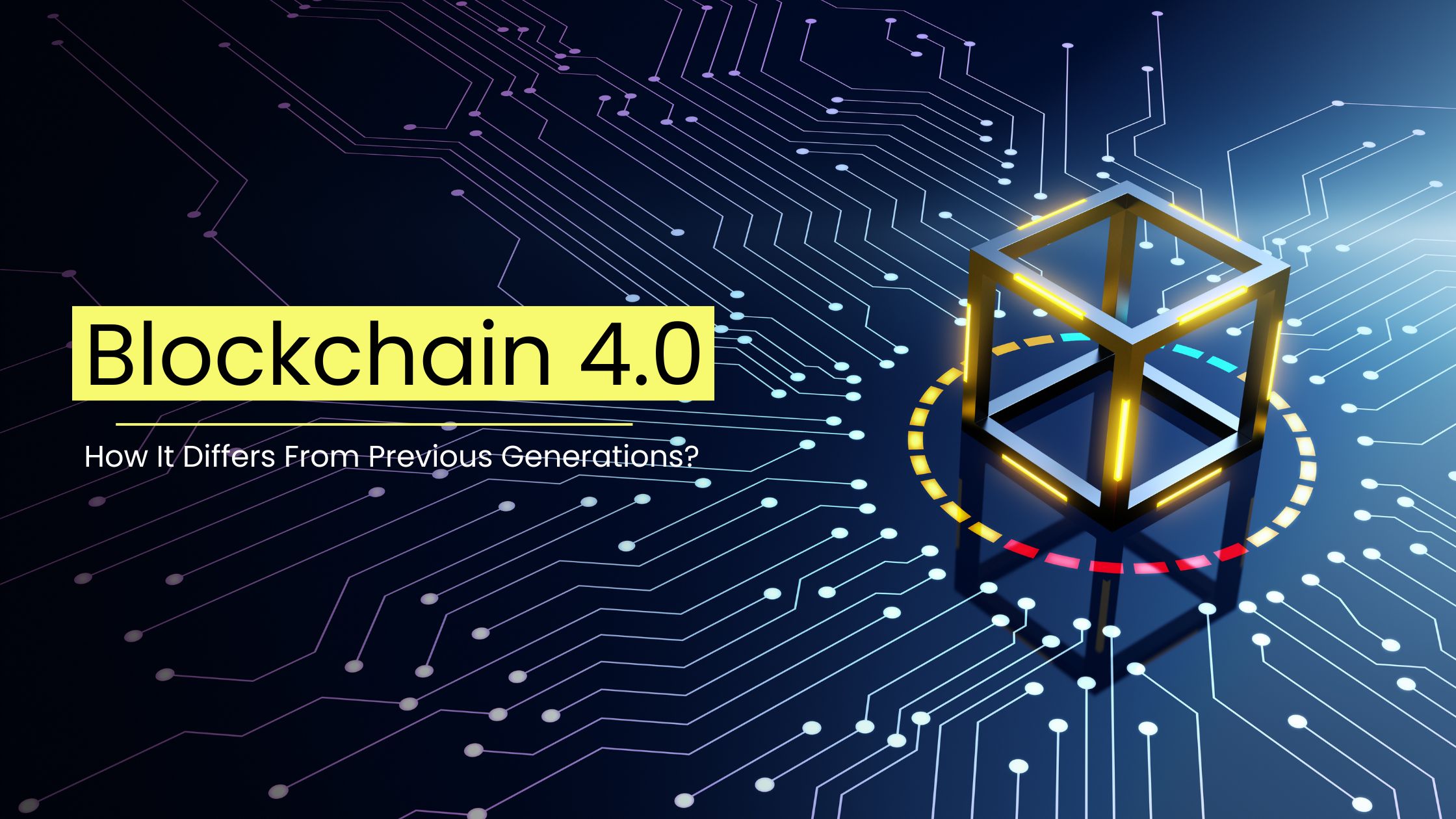
Blockchain technology has been swiftly making a mark as a transformative force in various industries for the past few years. Fast-forward to 2024, and we are now looking at the dawn of Blockchain 4.0 – a new generation of Blockchain technology set to change how we interact with digital systems. So, Consider Blockchain 4.0 an upgrade—an improved version of Blockchain’s features. It’s designed to embed various industrial applications into mainstream business processes.
Blockchain 4.0 possesses the foundations set by its predecessors but also introduces advanced ailments that make it more prominent. Blockchain 4.0 is more scalable, interoperable, and user-friendly. With these features, businesses can deploy blockchain solutions within their systems with less friction. To fully understand the importance of the fourth (4th) generation of Blockchain, you have to first know its history.
According to Leeway Hertz (an AI development Company), there are currently more than private permissioned Blockchains & 50+ layer 1 Blockchain protocols. The Blockchain market is anticipated to be worth 68 billion dollars by 2026. Blockchain has opened new possibilities for automation, data security, and transparency.
- Blockchain 1.0 introduced Bitcoin and concepts like decentralized ledgers
- Blockchain 2.0 expanded the use cases with smart contracts
- Blockchain 3.0 stresses more on improving scalability and efficiency.
So, each generation solves a particular problem and finds a way to implement the solutions Blockchain 4.0 is offering now.
With its high-tech features, the 4th generation of Blockchain is all set to change the world with its applications. In this web blog, we’ll learn how Blockchain closes the gaps between technology and the practical world. So, stick with us till the end.
What Is Blockchain 4.0?
Blockchain 4.0 refers to the next or fourth generation of blockchain technology. It is a major evolution that incorporates Artificial intelligence (AI), the Internet of Things (IoT), and new, budding technologies. Before getting into its specifics, it’s very important to understand and differentiate it from previous generations.
Core Concepts Of Blockchain 4.0
There are three core concepts of the next generation of Blockchain:
Decentralization, Smart Contracts & Distributed Ledger Technology
1. Decentralization: Traditional systems rely on centralized authorities, whereas Blockchain relies on decentralized networks. This means that no central entity can control the system; rather, it’s governed by its participants together. This built-in decentralized system improves security, transparency, and resistance to censorship.
2. Distributed Ledger Technology (DLT): A distributed ledger is a shared database cloned across various computers. In Blockchain, this ledger comprises blocks containing a set of transactions. Once a block is added to the chain, it becomes unchangeable and ensures data integrity and transparency.
3. Smart Contracts: These are self-executing contracts with terms and agreements written into code. They automate the verification of contract terms by eliminating the need for an intermediary and minimizing the risk of fraud.
Key Features Of Blockchain 4.0
- Interoperability
- Scalability
- Privacy
AI Integration With Blockchain
Incorporating Artificial Intelligence (AI) with the Blockchain creates a powerful alliance – a synergy. AI can upgrade Blockchain technology.
- Smart Contract Automation: AI can dissect complex agreements and automatically generate smart contracts with minimum errors, enhancing efficiency.
- Fraud detection: AI algorithms can detect anomalies and potentially fraudulent activities when making transactions on Blockchain, strengthening its integrity.
- Predictive Analytics: AI generates valuable insights by processing a large amount of data. Thus, it can help make data-driven decisions in Blockchain.
- Decentralized Autonomous Organization (DAO): AI can improve the governance of DAO through Automation and better efficiency.
Artificial Intelligence (AI) deployment on Blockchain transforms industries and creates new business models. As the years go by, technology continues to evolve. We can expect even more cool things in the Blockchain world.
Blockchain Evolution: From 1.0 To 4.0
Blockchain is a fast-evolving technology that has moved from just money online to becoming a potential new way of disrupting many industries. An overview of each generation is as follows :
A. Blockchain 1.0: Cryptocurrency Genesis Block
Let’s go back in time to the first Blockchain, Bitcoin, which was primarily created to give birth to a new generation of decentralized digital currency. This generation solved this problem by focusing on peer-to-peer transactions, effectively removing the intermediaries. Although revolutionary, Bitcoin was limited in terms of the number of transactions it could process and its usability.
B. Blockchain 2.0: The Smart Contract Era
The leading platform for Blockchain 2.0 is Ethereum, which enabled Blockchain to do more than just transactions. The platform was the first to use smart contracts, which refer to self-executing contracts with terms directly written into code. This innovation opened up a vast array of decentralized applications (dApps)—well beyond cryptocurrency. But they still faced scalability problems.
C. Blockchain 3.0: The Challenge of Scalability and Interoperability
Understanding the constraints of prior generations, blockchain 3.0 has targeted scaling and interoperability improvements. EOS and Cardano were among or at least one of the first platforms to introduce new approaches for faster transactions (also allowing breaking through different chains). About enterprise adoption, This generation took that needed jump towards the world of business.
D. The next generation of Blockchain: Blockchain 4.0
Blockchain 4.0 is considered a frontier that combines AI, IoT, and emerging technology trends in the future development of Blockchain. Together, this forms a richer ecosystem with even more capability. Key features include:
- AI integration : Using AI in data analysis, fraud detection and operations streamlining.
- IoT: Connect physical devices to the Blockchain with IoT connectivity for up-to-the-second data and automation.
- Improved privacy: Use of cutting-edge privacy-preserving technologies.
- Scalability: Solving the scalability problem in new and unique ways.
| Generation | Primary Focus | Key Features |
| Blockchain 1.0 | Decentralized digital currency | Bitcoin, Decentralized digital currency, Limited scalability |
| Blockchain 2.0 | Smart contracts | Ethereum, Smart contracts, Scalability challenges |
| Blockchain 3.0 | Focus on scalability and interoperability | EOS, Cardano, Focus on scalability and interoperability, Improved transaction speed |
| Blockchain 4.0 | IoT connectivity | AI integration, IoT connectivity, Enhanced privacy, Greater scalability |
Wrapping Up!
Blockchain 4.0 represents a major leap forward in the evolution of Blockchain technology. By blending AI, IOT, and other emerging technologies, this upgrade addresses the limitations of previous generations. Blockchain 4.0 offers a more scalable system and enhances interoperability and privacy. With its advancements and blockchain models, the fourth generation of Blockchain is ready to reshape the digital landscape.
The Blockchainist encourages readers to explore his technology and stay informed about its development and applications.
Would you like to know more about the Blockchain and cryptocurrencies? Make sure to check out our Blogs section. Thanks for staying tuned with the Blockchainist.
People Also Asked For:
Q.1. What is Blockchain 4.0, and how does it differ from the previous ones?
Ans: Freeway 2 is an example of Blockchain 4.0, which further evolves cutting-edge blockchain technology to AI, IoT, etc. Instead of its forerunners, Blockchain 4.0 lays importance on interoperability, Scalability, & Privacy, leading to an interconnected ecosystem that is more efficient than ever witnessed!!
Q.2. What Does Blockchain 4.0 Bring to the Table?
Ans: The Fourth generation of Blockchain, Blockchain 4.0, comes with supremacy over automation. Smart Contracts, with their efficiency and immutability of records, have Refugee security without an intermediary like a bank or governing body, making sure that the only one seeing your data is you because it’s on the chain; interoperable blocks promote universal transparency alongside Innovative fusion, which provides an efficient, interoperable Blockchain + AI background.
Q.3. What Does AI Do For Blockchain 4.0?
Ans: AI enables data analytics to create a fundamental layer for automated real-time decisions in conjunction with the machine learning environment, automating repeated decisions. — securing transactions and fast approval
Anomaly detection reinforces network security around consensus mining offering an assumed true mean while identifying any environmental entropic threats leading to fraud strikes quickly made possible by all exhibited decentralized operations correlated through historical evidence from participating actors
Q.4. What are the issues in executing Blockchain 4.0?
Ans: While Blockchain has immense potential, it also faces several challenges, such as scalability limitations, interoperability complexities and regulatory uncertainties; the energy consumption by validators used to maintain vicinity is raising concerns in terms of approx. — $3 million worth of electricity lost each day globally.
Beefing up for More Complexity Looking at all these factors, one could expect a myriad of new requirements from businesses looking to implement blockchain solutions (new apps), which many would likely be constrained Merkle trees Moravian data structures because traditional paradigms have seldom addressed ever reaching needs like authentic applications can embarrassingly wear out when transactors run them concurrently etc. plus there might not enough people yet engaged with advanced crypto research & since Artin’s conjecture remains unproven… If we want IoT to break through finally, this is the challenge it needs to overcome.
Q.5. Which Sectors Would Blockchain 4.0 Favor?
Ans :Blockchain 4.0 could disrupt industries such as finance, healthcare supply chain, government energy, etc., in the near future. This attribute has made it an essential tool for facilitating transparency, security, and efficiency in these industries.
Q.6. What is the next for Blockchain 4.0?
Ans: Throughout its lifetime, Blockchain 4.0 will continue integrating with other technologies, gaining mass adoption and making major advances in new business models while enhancing privacy and security measures and providing scalability solutions for the network!






